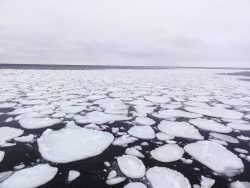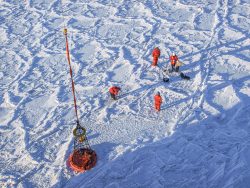The world of climate modeling is complex, requiring an enormous amount of coordination and collaboration to produce. Models feed on mountains of different inputs to run simulations of what a future world might look like, and can be so big — in some cases, lines of code in the millions — they take days or weeks to run. Building these models can be challenging, but getting them right is critical for us to see where climate change is taking us, and importantly, what we might do about it.

The models are a powerful tool, but they are only as good as the parameters and assumptions they are built on. Those need to be scrutinized and validated by scientists—and that’s where Lettie Roach, a postdoctoral researcher in Atmospheric Sciences at UW, and her collaborators come in. Their recent publication in Geophysical Research Letters evaluates 40 recent climate models focusing on sea ice, the relatively thin layer of ice that forms on the surface of the ocean, around Antarctica, and was coordinated and produced to inform the Intergovernmental Panel on Climate Change (IPCC).
“I am really fascinated by Antarctic sea ice, which the models have struggled more with than Arctic sea ice,” says Roach. “Not as many people are living near the Antarctic and there haven’t been as many measurements made in the Antarctic, making it hard to understand the recent changes in sea ice that we’ve observed through satellites.”
Roach and her colleagues found that all models project decreases in the aerial coverage of Antarctic sea ice over the 21st century under different greenhouse gas emission scenarios, but the amount of sea ice loss varies considerably between the lowest emission scenario and the highest.

The models they examined are known as coupled climate models, meaning they incorporate atmospheric, ocean, terrestrial and sea ice models to project what the future holds for our climate system. We are all familiar with the story of soon-to-be ice-free summers in the Arctic and the implications that may have on global trade. But what’s driving change around Antarctic sea ice and what’s expected in the future is less clear. Her team’s assessment of Antarctic sea ice in the new climate models is among the first.
“This project arose from a couple of workshops that were polar climate centered, but no one was leading an Antarctic sea ice group,” said Roach. “I put my hand up and said I would do it. The opportunity to lead something like this was fun, and I’m grateful to collaborators across many institutions for co-creating this work.”
The Antarctic is characterized by extremes. The highest winds, largest glaciers and fastest ocean currents are all found there, and getting a handle on Antarctic sea ice, which annually grows and shrinks six-fold, is critically important. To put that into perspective, that area is roughly the size of Russia. The icy parts of our planet — known as the cryosphere — have an enormous effect on regulating the global climate. By improving the simulation of Antarctic sea ice in models, scientists can increase their understanding of the climate system globally and how it will change over time. Better sea ice models also shed light on dynamics at play in the Southern Ocean surrounding Antarctica, which is a major component of our southern hemisphere.
“The previous generation of models was released around 2012,” says Roach. “We’ve been looking at all the new models released, and we are seeing improvements overall. The new simulations compare better to observations than we have seen before. There is a tightening up of model projections between this generation and the previous, and that is very good news.”

This process, where scientists critically evaluate climate models, has long been part of the IPCC approach. Scientists verify those model assumptions make sense, compare predictions to see if they align with observations from the field and make sure the highest quality data were used to underpin model performance. Asking these questions helps fine-tune models to perform at their best. These assessments have occurred for decades and continue to become more sophisticated as the models themselves become more sophisticated and powerful— and that’s great news as they continue to play an essential role in helping us all make sense of the world around us and how it is changing.
The scientific community works together very cohesively to develop climate projections for the IPCC reports. “The international effort that goes into developing models and sharing their output is hugely collaborative,” says Roach. “There’s a ton of work that goes into these models. I think they are the best tools we have to help us to understand climate change and what will happen in the future, and to provide good information for the policymakers to make decisions on.”

